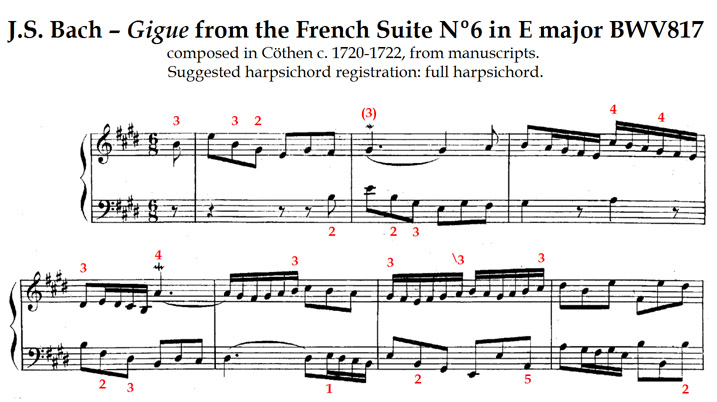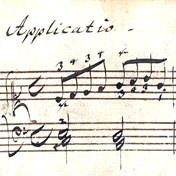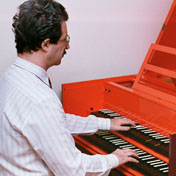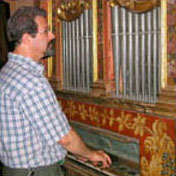Excerpts from the book
Fingering example in J.Ch. Bach and F.P. Ricci's Methode ou Recueil De Connoissances Elementaires pour le Forte-Piano ou Clavecin …. Paris 1786. Page 49
INTRODUCTION
Every keyboard player who has attempted to learn Baroque fingerings knows that the main difficulty lies in complex passages, for example sequences of ornaments and—very especially—scales and accidentals. The older Renaissance music relied heavily on scales, and a player only became proficient after—inevitably—practising scales “ad nauseam”, mostly with very few accidentals. Later in the Baroque era, however, other types of passages became more common than scales, and many Baroque pieces have no significant diatonic passage longer than the five notes one can play with the fingers of one hand. Eventually, however, some scales are found: especially if they have accidentals—no longer a rarity in Baroque music—or if the hand has also to play a few notes outside the scale, the player finds a serious technical hurdle. Ornaments are an added difficulty. To help the player to overcome these difficulties, I have selected a set of pieces that I have fingered according to the principles expounded in my Baroque fingering method. . . .
FINGERING PRINCIPLES
In the Baroque era, an amateur player would not have in mind the multiple finger crossings in the contemporary technique's palette. She/he would finger a piece not worrying if a less-than-adequate finger here and there yielded an irregular rhythm or articulation. A professional and teacher, such as François Couperin, would think differently, and would recommend fingerings that would facilitate—as much as possible—the desired control of performance down to the smallest details. . . .
Our goal here is to improve our own dexterity in Baroque keyboard technique, and for this purpose every piece here has been thoroughly fingered, not just the scales and ornaments. . . .
DETAILS ON THE PERFORMANCE OF EACH PIECE
. . . d'Anglebert's Folies d'Espagne is my favourite among the several extant sets of Baroque variations on this ancient harmonic sequence. d'Anglebert's work is a treasure trove of Baroque keyboard idioms: find here included the 6e Couplet, a true left hand Récit typical of contemporary organ music, and the 10e Couplet, based on scales per contrario motu. Note how the wavering melodic line and the notes inégales dictate the almost-exclusive passage of the 3rd finger, except of course for the 2nd finger that—as usual— crosses over the thumb when ascending with the left hand. In the 10e Couplet, the ascending passages for the right hand (3rd, 5th, 11th and 13th bar) are best played with “alternate staggering”, whereby the left hand plays standard—i.e. slight—inégales, while the right hand plays strong—i.e. triplet—inégales. This way, in each pair of inégales, the two hands coincide in the first one (strong beat and long), while in the second one (weak beat and short) the right hand is slightly delayed or "staggered". When judiciously and flexibly applied, this is an excellent effect. Needless to say, it is also historical: examples of notated staggered execution are found in some pieces by F. Couperin, Rameau and Forqueray. . . .
. . . F. Couperin's Les Petits Moulins à Vent is a deservedly well-known gem. It is also tricky to perform with the required mixture of regularity and a few micro-rubatos. The composer marked some of the latter with “breathing” signs: others are not written out, but are quite obvious, for example after the trill over f#' in bar 15. If we follow Couperin's tempo marking, Tres Légérement, this piece is to be played mostly égale, yet it sounds best not faster than 112 crotchets per minute: if so, the passages from the scales up to the end of each section are typical cases for slight inégales and have been fingered as such. . . .

Upper part of p.44 of this book




